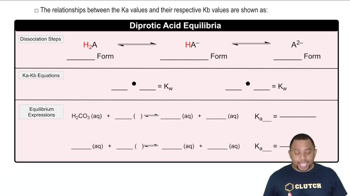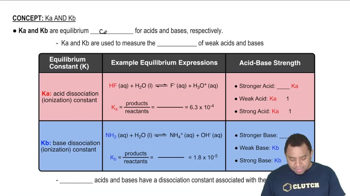Here are the essential concepts you must grasp in order to answer the question correctly.
Diprotic Acids
Diprotic acids are acids that can donate two protons (H⁺ ions) per molecule in an aqueous solution. This characteristic allows them to undergo two dissociation steps, each with its own acid dissociation constant (Ka). Understanding the behavior of diprotic acids is crucial for calculating pH and species concentrations, as each step influences the overall acidity and the resulting equilibrium concentrations.
Recommended video:
3 forms of Diprotic Acids
Acid Dissociation Constants (Ka)
The acid dissociation constant (Ka) quantifies the strength of an acid in solution, representing the equilibrium between the undissociated acid and its ions. A larger Ka value indicates a stronger acid that dissociates more completely. For diprotic acids, both dissociation steps have distinct Ka values, which are essential for determining the concentrations of all species in solution, especially when calculating pH.
Recommended video:
Characteristics of Ka and Kb
pH Calculation
pH is a measure of the hydrogen ion concentration in a solution, calculated using the formula pH = -log[H⁺]. For strong acids, the pH can often be determined directly from the concentration of the acid, while for weak acids, it requires consideration of the dissociation constants. In the case of diprotic acids like selenic acid, both dissociation steps must be accounted for to accurately calculate the pH and the concentrations of all species present.
Recommended video:
 Verified step by step guidance
Verified step by step guidance

